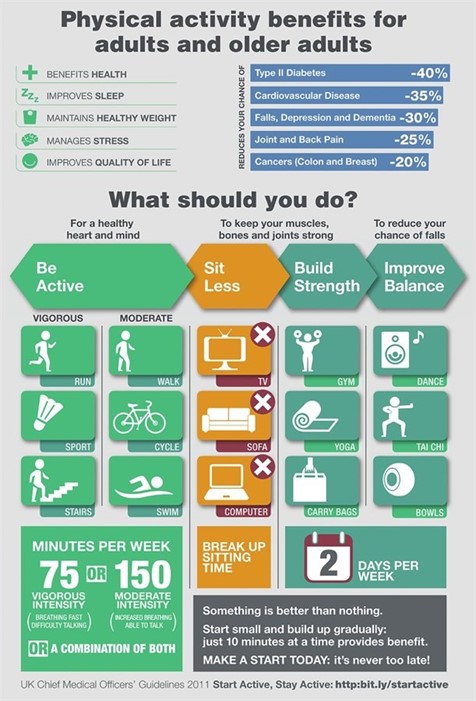“If exercise were a pill, it would be one of the most cost-effective drugs ever invented”
Dr. Nick Cavill
Physical activity
Evidence shows that the people of Scotland need to be more active with 73% of children and 40% of adults not achieving recommended activity levels. Walking improves health. There was good evidence for the health benefits of walking – as the infographic below demonstrates. As well as having significant physical health benefits such as improving heart, lung and joint health, there are also major improvements in mental health as well as the social aspect. It is a simple, cheap and effective way to maintain a healthy BMI and a improve quality of life.
Physical activity guidelines
Additional resources
NHS Get Active
Paths For All
Paths For All is an excellent website with great information aiming to get people walking everyday. Visit their website.
Parkrun is also an excellent option. Parkruns are free, weekly, community events all around the world. Saturday morning events are 5k and take place in parks and open spaces.
On Sunday mornings, there are 2k junior parkruns for children aged four to 14. It is a positive, welcoming and inclusive experience where there is no time limit and no one finishes last. Everyone is welcome to come along, whether you walk, jog, run, volunteer or spectate. Visit the website for more information about a Parkrun close to you.
Couch to 5k
A week-by-week description of the 9-week set of Couch to 5K podcasts. Each week involves 3 runs. Visit the website for more information.
Benefits of physical activity

The video ‘23 and a half hours – What is the single best thing we can do for our health’ by Mike Evans. It is an excellent way of demonstrating that 30 minutes per day of activity can have a profound positive effect on our health.
Strength and conditioning
There is good evidence to suggest that strength training is useful in reducing injuries – in some cases it is reported to reduce sports injuries to less than one third and overuse injuries by half. This doesn’t necessarily mean joining a gym and doing weights. Simple exercises performed safely, and in the comfort of your own home can be just as good.
There is also good evidence to support exercise and resistance training for managing cardiovascular disease risk factors and peripheral arterial disease (PAD). PAD is when there is reduced muscle blood supply to the lower limb which can cause muscle weakness, cramp or discomfort in the lower limb.
Due to this, some people believe the pain induced by it can be harmful. This might lead to increased sedentary behaviour, reduced aerobic capacity or cardiorespiratory fitness, and reduced muscle strength and endurance, all impairing walking ability further and ultimately reducing quality of life. If you want to speak to someone before beginning exercise, please contact on the number below. Visit the Physical Activity, Strengthening & Falls Prevention page for further information.
Recent research also shows strong evidence of strength training having a positive effect on musculoskeletal disorders as regards employees who work in physically demanding jobs.
Sarcopenia
Sarcopenia is a condition characterized by loss of skeletal muscle mass and function. Its development may be associated with conditions that are not exclusively seen in older persons, although it is primarily a disease of the elderly. Sarcopenia is characterized by progressive and generalized loss of skeletal muscle mass and strength and it is strictly correlated with physical disability and mortality. It is highly correlated with frailty and risk of falls in eldery (see falls below). Risk factors for sarcopenia include age, gender and level of physical activity.
There is an established link between inactivity and losses of muscle mass and strength, this suggests that physical activity should be a protective factor for the prevention but also the management of sarcopenia.
Please speak to your GP or any of the Allied Health professionals that you may have an appointment with – for example Podiatrist, Physiotherapist, Occupational therapist – for more information and advice if required.
Risk of falls
Falls are a common, but often overlooked, cause of injury. Around 1 in 3 adults over 65 who live at home will have at least one fall a year, and about half of these will have more frequent falls. Exercises that target balance, gait and muscle strength have been found to prevent falls in these people. Exercise reduces the number of falls over time by around one quarter (23% reduction) which means if there were 850 falls in 1000 people followed over 1 year, exercise would result in 195 fewer falls. Read the Cochrane Review on Exercise for preventing falls in older people living in the community.
This study that provides evidence foot and ankle problems are important risk factors for falls in older people – particularly reduced ankle flexibility, hallux valgus deformity, decreased tactile sensitivity and decreased toe plantarflexor strength, and doing some simple exercises to address these modifiable risk factors may be beneficial in reducing falls.
The video below demonstrates some exercises you may find useful.
Please note: If you want to speak with someone for more advice and support regarding exercises please phone 0141 347 8909.
